Around the World
September/October 2021
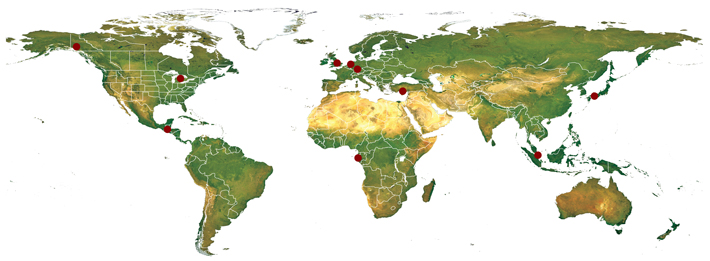

-
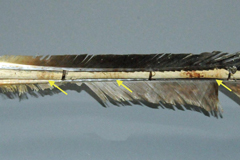 CANADA: When archaeologists in the southern Yukon recovered a 6,000-year-old atlatl dart—a deadly projectile used by First Nations peoples—from melting alpine ice, they noticed it was coated with a mysterious orangish substance. The researchers initially suspected it was red ochre, but further examination revealed that it was actually castoreum, a secretion beavers use to mark their territory. This is the first known archaeological evidence of the substance’s use. It might have been applied to the dart as an adhesive, a preservative, or a colorant.
CANADA: When archaeologists in the southern Yukon recovered a 6,000-year-old atlatl dart—a deadly projectile used by First Nations peoples—from melting alpine ice, they noticed it was coated with a mysterious orangish substance. The researchers initially suspected it was red ochre, but further examination revealed that it was actually castoreum, a secretion beavers use to mark their territory. This is the first known archaeological evidence of the substance’s use. It might have been applied to the dart as an adhesive, a preservative, or a colorant. -
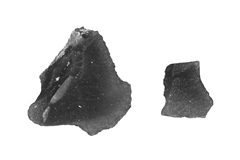 MICHIGAN: Flakes from 9,000-year-old obsidian tools were recently recovered from a Paleoindian hunting site that now lies more than 100 feet under Lake Huron. Obsidian, a black volcanic glass, was a prized resource used by members of ancient cultures to make sharp tools. There is no local obsidian source. Researchers traced the origins of the obsidian used in the tools to a quarry in central Oregon, 2,500 miles away. This suggests that an extensive trade network existed toward the end of the last Ice Age.
MICHIGAN: Flakes from 9,000-year-old obsidian tools were recently recovered from a Paleoindian hunting site that now lies more than 100 feet under Lake Huron. Obsidian, a black volcanic glass, was a prized resource used by members of ancient cultures to make sharp tools. There is no local obsidian source. Researchers traced the origins of the obsidian used in the tools to a quarry in central Oregon, 2,500 miles away. This suggests that an extensive trade network existed toward the end of the last Ice Age. -
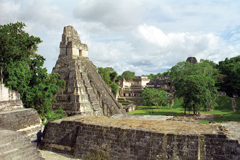 GUATEMALA: At its zenith in the 9th century A.D., the Maya city of Tikal had a population of around 60,000. It was a bustling metropolis of buildings, plazas, and roads in the middle of a rain forest. Yet, despite the urban sprawl, lush green spaces were maintained. Analysis of plant DNA found in sediments surrounding reservoirs in the city’s center indicates that even at Tikal’s height, more than 30 different species of plants, trees, and grasses lined the reservoirs’ banks, providing shady, cool urban oases.
GUATEMALA: At its zenith in the 9th century A.D., the Maya city of Tikal had a population of around 60,000. It was a bustling metropolis of buildings, plazas, and roads in the middle of a rain forest. Yet, despite the urban sprawl, lush green spaces were maintained. Analysis of plant DNA found in sediments surrounding reservoirs in the city’s center indicates that even at Tikal’s height, more than 30 different species of plants, trees, and grasses lined the reservoirs’ banks, providing shady, cool urban oases. -
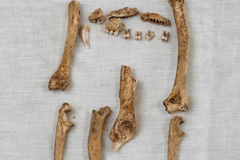 ENGLAND: Renovations of Nottingham Castle revealed the skeletal remains of some rather surprising former residents—3 guenon monkeys. The primates, which are native to central and western Africa, seem to have died of natural causes at a relatively old age. Researchers believe they were kept as pets or as part of a menagerie by a flamboyant socialite named Miss Jane Kirkby, who lived in one of the castle’s apartments from 1791 to 1825. Miss Kirkby was known for her eccentric dinner parties.
ENGLAND: Renovations of Nottingham Castle revealed the skeletal remains of some rather surprising former residents—3 guenon monkeys. The primates, which are native to central and western Africa, seem to have died of natural causes at a relatively old age. Researchers believe they were kept as pets or as part of a menagerie by a flamboyant socialite named Miss Jane Kirkby, who lived in one of the castle’s apartments from 1791 to 1825. Miss Kirkby was known for her eccentric dinner parties. -
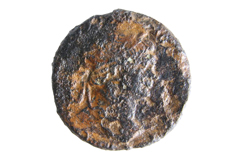 THE NETHERLANDS: Most ancient Romans probably couldn’t swim, so they put their lives at risk whenever they needed to cross a river. Sometimes, they would entreat protective gods to provide them safe passage. A collection of more than 100 coins dating from the 1st century B.C. to the 1st century A.D. found near the town of Berlicum likely marks the spot where Roman travelers once forded the River Aa and tossed coins into the water as offerings, hoping to reach the opposite shore unharmed.
THE NETHERLANDS: Most ancient Romans probably couldn’t swim, so they put their lives at risk whenever they needed to cross a river. Sometimes, they would entreat protective gods to provide them safe passage. A collection of more than 100 coins dating from the 1st century B.C. to the 1st century A.D. found near the town of Berlicum likely marks the spot where Roman travelers once forded the River Aa and tossed coins into the water as offerings, hoping to reach the opposite shore unharmed. -
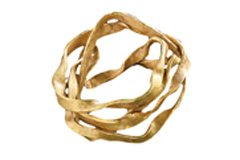 GERMANY: The grave of a 20-year-old Bronze Age woman buried near Tübingen 2,800 years ago contained only a single artifact—a delicate gold ribbon. This is the oldest piece of gold jewelry ever found in the region. The gold itself may have come from Cornwall, England. Experts believe the woman wore the ribbon in her hair and that its presence indicates she came from a family of high social standing.
GERMANY: The grave of a 20-year-old Bronze Age woman buried near Tübingen 2,800 years ago contained only a single artifact—a delicate gold ribbon. This is the oldest piece of gold jewelry ever found in the region. The gold itself may have come from Cornwall, England. Experts believe the woman wore the ribbon in her hair and that its presence indicates she came from a family of high social standing. -
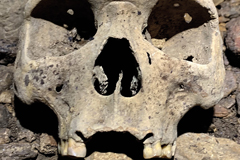 GABON: The scattered remains of 24 adults and 4 children were found deep within Iroungou Cave, which was used as a burial site in the 14th and 15th centuries A.D. The deceased individuals were lowered down or dropped 80 feet through a narrow opening in the cave’s ceiling. Almost all the adults had undergone a dental procedure in which the upper central and lateral incisors were deliberately removed, giving them a distinctive appearance.
GABON: The scattered remains of 24 adults and 4 children were found deep within Iroungou Cave, which was used as a burial site in the 14th and 15th centuries A.D. The deceased individuals were lowered down or dropped 80 feet through a narrow opening in the cave’s ceiling. Almost all the adults had undergone a dental procedure in which the upper central and lateral incisors were deliberately removed, giving them a distinctive appearance. -
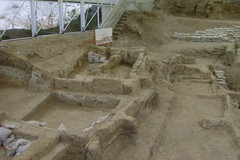 TURKEY: Çatalhöyük is considered one of the world’s earliest proto-urban settlements. At its peak, from 7100 to 5700 B.C., its 8,000 inhabitants lived in densely packed one-room houses without doors or windows, which were entered through small openings in their roofs. A new experimental archaeology project has helped researchers determine that when fires were burning in these houses’ ovens, the lack of ventilation would have exposed residents to dangerous levels of air pollution. This likely caused respiratory illnesses and other ailments.
TURKEY: Çatalhöyük is considered one of the world’s earliest proto-urban settlements. At its peak, from 7100 to 5700 B.C., its 8,000 inhabitants lived in densely packed one-room houses without doors or windows, which were entered through small openings in their roofs. A new experimental archaeology project has helped researchers determine that when fires were burning in these houses’ ovens, the lack of ventilation would have exposed residents to dangerous levels of air pollution. This likely caused respiratory illnesses and other ailments. -
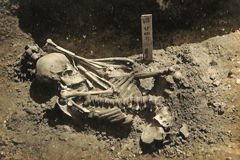 JAPAN: A man who was buried more than 3,000 years ago at the Tsukumo shell mound site appears to be the earliest known shark attack victim. Ever since his skeleton was discovered more than a century ago, researchers have been perplexed by the man’s cause of death, which presumably resulted from his 790 unusual wounds. New analysis has shown that his injuries were likely inflicted by the teeth of either a tiger or great white shark during an attack that also left him without his left hand and right leg.
JAPAN: A man who was buried more than 3,000 years ago at the Tsukumo shell mound site appears to be the earliest known shark attack victim. Ever since his skeleton was discovered more than a century ago, researchers have been perplexed by the man’s cause of death, which presumably resulted from his 790 unusual wounds. New analysis has shown that his injuries were likely inflicted by the teeth of either a tiger or great white shark during an attack that also left him without his left hand and right leg. -
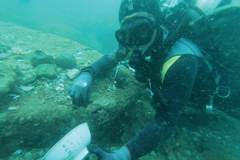 SINGAPORE: Two shipwrecks dating to the period when Singapore was a key stop on the trade route connecting the Indian Ocean with the South China Sea were discovered in the waters near the outlying island of Pedra Branca. The older of the 2 ships sank in the 14th century. The other has been identified as Shah Munchah, an Indian-built ship that wrecked in 1796. It carried a huge cargo of Chinese ceramics and blue-and-white Yuan Dynasty porcelain destined for Great Britain.
SINGAPORE: Two shipwrecks dating to the period when Singapore was a key stop on the trade route connecting the Indian Ocean with the South China Sea were discovered in the waters near the outlying island of Pedra Branca. The older of the 2 ships sank in the 14th century. The other has been identified as Shah Munchah, an Indian-built ship that wrecked in 1796. It carried a huge cargo of Chinese ceramics and blue-and-white Yuan Dynasty porcelain destined for Great Britain.
Advertisement
IN THIS ISSUE
Features
The Pursuit of Wellness
Secret Rites of Samothrace
Searching for the Fisher Kings
Letter from Scotland
Digs & Discoveries
Viking Fantasy Island
Kaleidoscopic Walls
For Eternity
Maryland's First Fort
Snake Guide
Man of the Moment
Kiwi Colonists
Leisure Seekers
Neanderthal Hearing
Head of State
A Twisted Hoard
Crowning Glory
Herodian Hangout
Off the Grid
Around the World
Maya city parks, Paleoindian obsidian traders, Çatalhöyük smoke alarm, and a shark attack in Japan
Artifact
Putting a finger on fate
Advertisement

Recent Issues
-
 May/June 2024
May/June 2024
-
 March/April 2024
March/April 2024
-
 January/February 2024
January/February 2024
-
 November/December 2023
November/December 2023
-
 September/October 2023
September/October 2023
-
 July/August 2023
July/August 2023
-
 May/June 2023
May/June 2023
-
 March/April 2023
March/April 2023
-
 January/February 2023
January/February 2023
-
 November/December 2022
November/December 2022
-
 September/October 2022
September/October 2022
-
 July/August 2022
July/August 2022
-
 May/June 2022
May/June 2022
-
 March/April 2022
March/April 2022
-
 January/February 2022
January/February 2022
-
 November/December 2021
November/December 2021
-
 September/October 2021
September/October 2021
-
 July/August 2021
July/August 2021
-
 May/June 2021
May/June 2021
-
 March/April 2021
March/April 2021
-
 January/February 2021
January/February 2021
-
 November/December 2020
November/December 2020
-
 September/October 2020
September/October 2020
-
 July/August 2020
July/August 2020
-
 May/June 2020
May/June 2020
-
 March/April 2020
March/April 2020
-
 January/February 2020
January/February 2020
-
 November/December 2019
November/December 2019
-
 September/October 2019
September/October 2019
-
 July/August 2019
July/August 2019
-
 May/June 2019
May/June 2019
-
 March/April 2019
March/April 2019
-
 January/February 2019
January/February 2019
-
 November/December 2018
November/December 2018
-
 September/October 2018
September/October 2018
-
 July/August 2018
July/August 2018
-
 May/June 2018
May/June 2018
-
 March/April 2018
March/April 2018
-
 January/February 2018
January/February 2018
-
 November/December 2017
November/December 2017
-
 September/October 2017
September/October 2017
-
 July/August 2017
July/August 2017
-
 May/June 2017
May/June 2017
-
 March/April 2017
March/April 2017
-
 January/February 2017
January/February 2017
-
 November/December 2016
November/December 2016
-
 September/October 2016
September/October 2016
-
 July/August 2016
July/August 2016
-
 May/June 2016
May/June 2016
-
 March/April 2016
March/April 2016
-
 January/February 2016
January/February 2016
-
 November/December 2015
November/December 2015
-
 September/October 2015
September/October 2015
-
 July/August 2015
July/August 2015
-
 May/June 2015
May/June 2015
-
 March/April 2015
March/April 2015
-
 January/February 2015
January/February 2015
-
 November/December 2014
November/December 2014
-
 September/October 2014
September/October 2014
-
 July/August 2014
July/August 2014
-
 May/June 2014
May/June 2014
-
 March/April 2014
March/April 2014
-
 January/February 2014
January/February 2014
-
 November/December 2013
November/December 2013
-
 September/October 2013
September/October 2013
-
 July/August 2013
July/August 2013
-
 May/June 2013
May/June 2013
-
 March/April 2013
March/April 2013
-
 January/February 2013
January/February 2013
-
 November/December 2012
November/December 2012
-
 Sep/Oct 2012
Sep/Oct 2012
-
 September/October 2012
September/October 2012
-
 July/August 2012
July/August 2012
-
 May/June 2012
May/June 2012
-
 March/April 2012
March/April 2012
-
 January/February 2012
January/February 2012
-
 November/December 2011
November/December 2011
-
 September/October 2011
September/October 2011
-
 July/August 2011
July/August 2011
-
 May/June 2011
May/June 2011
-
 March/April 2011
March/April 2011
-
 January/February 2011
January/February 2011
Advertisement






